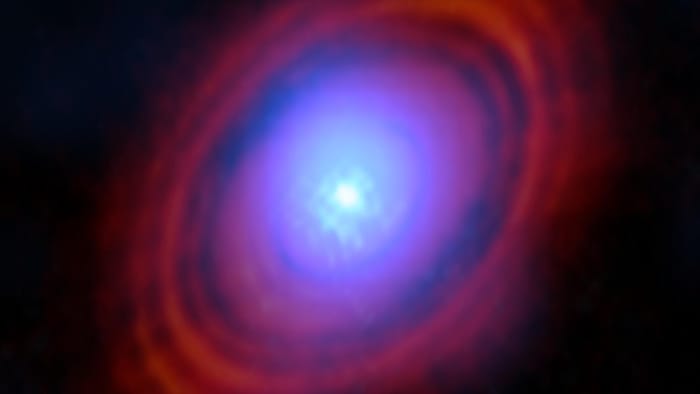Open in full screen mode In this image, the new observations show water vapor in shades of blue. Near the center of the disk, where the young star lives, the environment is hotter and the gas brighter. The red colored rings are previous ALMA observations showing the distribution of dust around the star. Agence France-Presse Water vapor has been detected for the first time in the disk surrounding a young star, at the precise location where planets could form in the future, shows a study published in the journal Nature Astronomy (New window)(in English). This detection was carried out around the very young star HL Tauri using the ALMA radio-astronomical telescope installed in Chile.
ALMA antennas look toward the starry night sky.
I never imagined that we could get an image of an ocean of water vapor in the very region where a planet is likely to form, commented Stefano Facchini, an astronomer at the University of Geneva. University of Milan, and first author of the study.
Located in the Taurus constellation and very close to Earth, just 450 light years away, HL Tauri, twice as massive as the Sun, has long been in the crosshairs of terrestrial and space telescopes.
Because its proximity and its youth – a million years at most – offer a breathtaking view of its protoplanetary disk, the cluster of gas and dust surrounding a star that allows planets to form.
Loading
Québec invests more than $600 million to improve the emergency prehospital system
ELSEWHERE ON INFO: Quebec is investing more than $600 million to improve the emergency prehospital system Loading in progress
Québec invests more than $600 million to improve the emergency prehospital system
ELSELSE ON NEWS: Quebec invests more of $600 million to improve the emergency prehospital system
According to theoretical models, this formation process would be particularly fruitful at a very specific location on the disk: the ice line. Where water, which is in the form of vapor near the star, changes to a solid state as it cools. The dust grains would coagulate with each other all the more easily thanks to the ice that covers them.
The most precise image ever taken with ALMA – more precise than the images usually obtained in the visible with the Hubble telescope. It shows the protoplanetary disk surrounding the young star HL Tauri.
As early as 2014, ALMA had produced unparalleled images of the protoplanetary disk, showing alternation of luminous rings and dark furrows. The latter would betray the presence of embryos of planets forming by accumulation of dust.
Other instruments had detected water around HL Tauri, the study recalls, but with too low a resolution to precisely delineate the ice line. From its high altitude location, more than 5,000 meters high, in the Chilean Atacama Desert, the European Southern Observatory (ESO) radio telescope is the first to identify this boundary.
To date, ALMA is the only facility capable of spatially resolving the presence of water in a cold planet-forming disk, claimed Professor Wouter Vlemmings of Sweden's Chalmers University, co-author of the study. ;study and cited with Professor Facchini in an ESO press release.
The radio telescope detected the equivalent of " at least three times the amount of water contained in all of Earth's oceans. All in an area quite close to the star, with a radius equivalent to 17 times the distance separating the Earth from the Sun.
Perhaps even more significant: ALMA images reveal a significant amount of water vapor at various distances from the star, including a gap where a planet could potentially form ahead. ;at present time, according to Professor Facchini.
The raw material for the formation of such a planet does not seem to be lacking, the calculations of x27;another observatory estimating the mass of available dust at the equivalent of thirteen times the mass of the Earth.
The study would thus show how the presence of water can influence the development of a planetary system, as was the case 4.5 billion years ago in our own solar system, according to Stefano Facchini.< /p>
However, understanding the mechanism of formation of the planets of the solar system remains incomplete.

